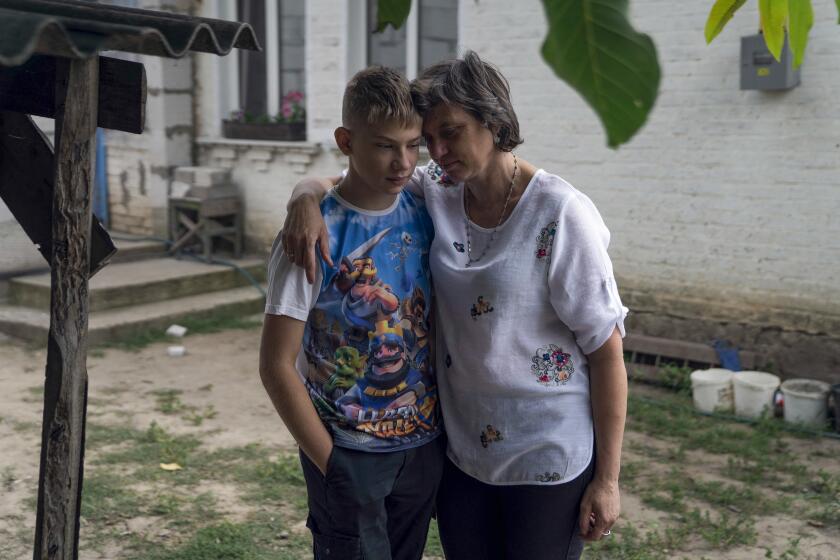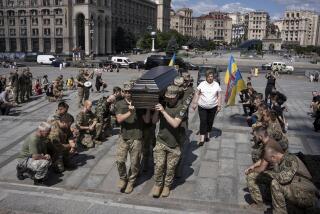As summer wanes, a water crisis looms for east Ukrainian city

- Share via
SLOVYANSK, Ukraine — The echo of artillery shells thundering in the distance mingles with the din of people gathered around Slovyansk’s public water pumps, piercing the uneasy quiet that smothers the nearly deserted streets of this eastern Ukrainian city.
The members of Slovyansk’s dwindling populace emerge only a few minutes at a time to fill up at the pumps that have been the city’s only water source for more than two months. Fighting between Ukrainian and Russian forces near the key city in the Donetsk region has damaged vital infrastructure that has cut residents off from gas and water for months.
The water flows for now, but fears grow that, come winter, the city only seven miles from Russian-occupied territory could face a humanitarian crisis once the pipes begin to freeze over.
“The water infrastructure was destroyed by the constant battles,” said Lyubov Mahlii, a 76-year-old widow who gathers about five gallons of water twice a day from a public tank near her apartment, dragging the plastic bottles up four flights of stairs on her own.
“When there are bombings and sirens, we keep carrying it,” she said Sunday. “It’s a great risk for us, but what can we do?”
Only one-fifth of the city’s pre-invasion population of 100,000 remains. With heavy fighting raging only miles away as Russian forces continue their push in Donetsk — part of the industrial Donbas region where Moscow-backed separatists have been battling Ukrainian troops since 2014 — residents defy the shelling to make do with the only water source left. Local officials believe things will get worse once the cold sets in.
Tymophiy, 12, lost his mother and stepfather in a hail of Russian fire and is now in the care of relatives. His diary is a record of fury and grief.
Residents fill their bottles with hand pumps or from plastic tanks at one of five public wells before hauling them home in bicycle baskets, wheeled carts and even children’s strollers.
Speaking from her tidy kitchen after one such trip, Mahlii said she boils some water for at least 15 minutes to make sure it’s safe for consumption. The remainder is used for bathing, washing clothes and dishes, watering plants and taking care of a stray dog named Chapa.
Following the death of her husband, Nikolai, from diabetes four years ago, Mahlii shares her Soviet government-provided apartment with two bright yellow canaries and an assortment of houseplants.
Water she had gathered filled the plastic tubs and buckets stacked on every flat surface in her small bathroom, while empty plastic bottles lined the walls in her hallway. A meat and vegetable soup was cooking on an electric burner for lunch.
The old imperial city of Odesa is infused with Russian history. But war has cemented its Ukrainian identity.
Ukrainian President Volodymyr Zelensky issued a mandatory evacuation order to all residents of the Donetsk region at the end of July, saying that remaining would cost lives. Despite that and the terror that accompanies the shriek of falling rockets near the city, with no money to relocate and nowhere to go, Mahlii plans to stay in Slovyansk — no matter what.
“I don’t want to leave my apartment because someone else might occupy it,” she said. “I don’t want to leave. I will die here.”
Another Slovyansk resident, Ninel Kyslovska, 75, gathered water from a tank at a park Sunday for marinating cucumbers in the sun that afternoon. She said the scarcity had upended all aspects of her life.
“Without water, you won’t get anywhere. I have to carry 60, 80, 100 liters of water a day and it’s still not enough,” she said. “Bread and water are sacred, and they just took it from people. Such actions must be punished, maybe not by us, but hopefully by God’s judgment.”
Breaking News
Get breaking news, investigations, analysis and more signature journalism from the Los Angeles Times in your inbox.
You may occasionally receive promotional content from the Los Angeles Times.
Filling her bottles, Kyslovska said she sometimes avoids bathing to save herself a trip to the park, and often washes her clothing in a nearby lake.
She blamed the local government for the lack of running water, complaining that nearby Kramatorsk — just six miles to the south — still had water flowing from its taps.
But Oleksandr Goncharenko, the head of Kramatorsk’s military administration, said even that comparative luxury was threatened by winter, when the temperature drops to minus-4 degrees.
“All these wells and pumps will freeze,” Goncharenko said, adding that places like Slovyansk and Kramatorsk — which also has no gas — had become “hostages of destroyed infrastructure.”
Analysts warn that Russia is moving troops and equipment in the direction of the ports to stave off a Ukrainian counteroffensive.
Goncharenko said Kramatorsk would drain municipal pipes that run into unheated structures to prevent them from freezing and bursting, and that he was “99% certain” that gas wouldn’t be restored before winter. Electricity cuts and the lack of heating could also see the fire risk soar as people try to heat and light their homes by other means, he added.
Ukrainian officials are still trying to convince the Donetsk region’s remaining residents to evacuate as the war’s front line threatens to move westward and the inhospitable winter looms.
Officials in Kramatorsk plan to build more public wells to supply the remaining population, but Goncharenko warned that the water quality couldn’t be guaranteed. Such water would likely be sourced from deep underground, he said, which would be too high in calcium and unfit for drinking.
Mahlii hasn’t made plans for what she’ll do once cold weather arrives, but after 47 years in her Slovyansk apartment, she will face whatever comes from her home.
“We are surviving!” she said. “We are surviving by any means.”
More to Read
Sign up for Essential California
The most important California stories and recommendations in your inbox every morning.
You may occasionally receive promotional content from the Los Angeles Times.













